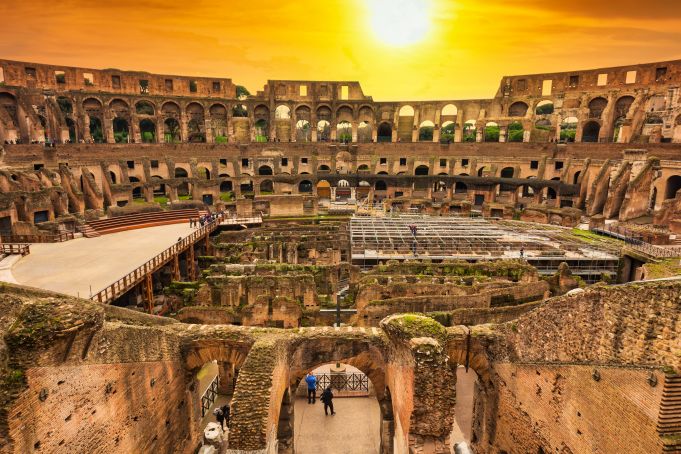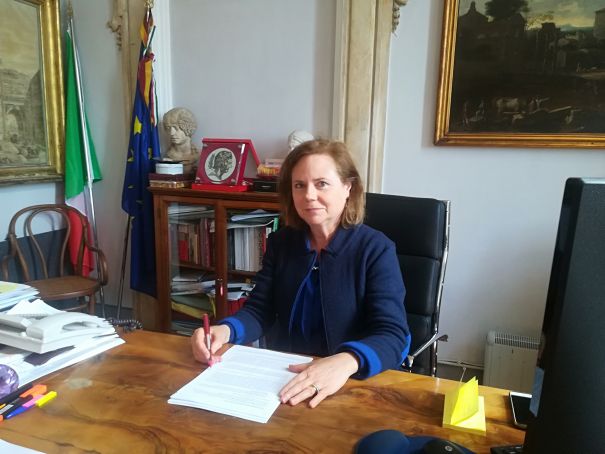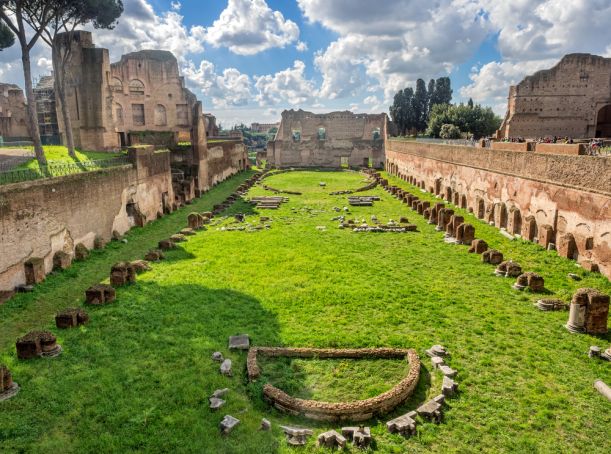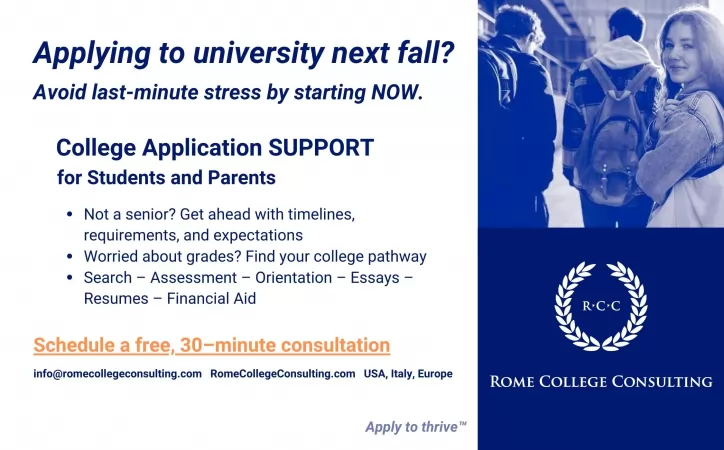Alfonsina Russo, director of the Colosseum Archaeological Park, talks to Wanted in Rome about the new realities of managing one of the world's most visited tourist sites in the era of covid-19.
Interview by Andy Devane
Italian archaeologist Alfonsina Russo is the director of the Parco Archeologico del Colosseo which, in addition to the Colosseum, includes the Roman Forum, the Palatine Hill and the Domus Aurea. In 2019 the Colosseum was named the most popular tourist attraction in the world, based on booking data compiled by TripAdvisor, attracting 7.5 million visitors last year.
WiR: As Italy enters phase two of the coronavirus emergency, and museums and archaeological sites get ready to reopen to the public, what preventive measures will be in place at the Colosseum's archaeological park to reduce potential exposure to the virus?
AR: The archaeological park had already implemented all the measures for the protection and health of both the staff and the public before the prime ministerial decree of 8 March [when Italy closed all museums and archaeological sites], and we shall now intensify our actions. I refer to the personal protective equipment (PPE), such as disposable gloves, masks, hand sanitisers – which have been available since December, and therefore long before the emergency started – but also to disinfecting and sanitising the shared spaces such as bathrooms and offices every day.Looking at the details of the long-term measures, which will be co-ordinated in conjunction with MiBACT (Italy's ministry of cultural heritage and tourism), we are considering a rethink of the ticketing process. This could involve all tickets being bought online, as well as longer time slots for visitors and more time between each slot, quota systems – already in place at some monuments in the Parco – and diversified visitor routes.
We shall benefit from the extension of WiFi across the whole park and the creation of additional digital aids, which have already been planned, such as the webAPP Il Parco tra le mani (The park in your hands). All visitors – Italians, foreigners, children and the visually impaired – will be able to download content from a QR code directly to their mobile device. We are also studying ways of using both the audio and video guide via QR code.

Have there been any advantages to being closed? For example, has the closure been a time to reflect on ways to improve the visitor experience, or to allow for essential maintenance works to be carried out?
The pandemic, which is bringing the culture sector to its knees, did not catch us unprepared. The ministry's strategic policy in recent years has put the public at the centre of its strategies of safeguarding and enhancement. Moreover culture continued during the lockdown and Colosseum Archaeological Park, by increasing activity on its website and on social networks, participated actively in the communication campaigns promoted by MiBACT to help Italians stay in touch with art and culture.
But an online visit can never replace the real thing. So we are aiming to increase public loyalty by launching a membership system, to strengthen the connection with people living in Rome and Lazio. Among other things we shall be promoting turismo di prossimità (a new form of local tourism in the coronavirus era), to encourage Italians to visit the wonders on their doorstep. We are looking at ways to attract families and we are targeting educational activities.
We also took the opportunity to carry out some maintenance works that we have always been putting off so as not to interfere with the public: at the Colosseum we have repaired the floor, painted railings and parapets, removed weeds from the walls; at the Roman Forum and Palatine Hill we have resurfaced some paths and increased pruning and grass cutting.
Parco Colosseo has maintained a prominent online presence throughout the closure – more so than usual – do you think social media will play an enhanced role in the future?
Yes, I think so, even though I have always considered online communication important even in phase one of the coronavirus pandemic. In phase two, in addition to the actual visitors to the archaeological park, we shall also give the same importance and attention to digital visitors, who are a completely new audience, and offer them a genuine visitor experience.
It will be necessary to increase their involvement, to identify new types of visits, for example with the support of tour guides, whose work has been almost wiped out by this difficult situation, and who we are now trying to reintegrate into the system. Going still further I also think that the "distance" can be reduced not only by increased interaction with websites and social media, but also, as the director general of Italy's museums Antonio Lampis proposed recently, by using a new cinematic type of language, similar to that already tested in video games.

How has the closure affected the programming of important events such as the Raphael exhibition at the Domus Aurea (which was scheduled to open on 24 March) or archaeological excavations such as the dig at the Curia-Comitium complex in the Roman Forum?
We have had to postpone everything until we know that the health situation is safe. We intend to keep the appointments we made, certainly in relation to the exhibition of Raphael in the Domus Aurea. We had in any case planned to keep this open until January 2021 in order to mark the entire year that celebrates the 500th anniversary of the death of Raphael. As far as the excavations are concerned, we are revising our budget but we hope we shall not have to give up research which, together with the protection and maintenance of the site, is the beating heart of the archaeological park.
What is the estimated loss so far in terms of visitors and ticket sales, and will the loss in revenue have a negative impact on any projects planned in the near future?
We have not made estimates yet and and it is too premature to do so. However, as I said, we are currently carrying out a budget review. We had a surplus in 2019 that will allow us to continue with our activities, giving priority to the maintenance and care of the cultural heritage. We shall also respect the national solidarity fund under which the special superintendence of Rome and the Italian museum system receive 30 per cent and 20 cent of the park's total revenues respectively.

In recent years the Colosseum has achieved record numbers of tourists. How do you see 2020 working out in terms of numbers – and profile – of visitors?
Given the gloomy outlook for international tourism, I expect a dramatic reduction in museums' ability to attract visitors, as the number of foreign tourists – which in the case of the park make up about 70 per cent of annual visits – will be reduced to zero, at least to begin with. For a while it will be necessary to give priority to the turismo di prossimità, but this is something I have always been very clear about, ever since I took up my post as the head of the park in 2017: in recent years the reopening of the Curia as a meeting place, the opening of new thematic routes and a closer relationship with schools have all been designed to involve the city and the greater Rome area.
In the same way, we have chosen to replace the outgoing exhibition Carthago. Il mito immortale with an exhibition dedicated to POMPEI. Lo sguardo di Roma, thanks to agreements with the Museo Archaeologico Nazionale di Napoli (MANN) and with the Archaeological Park of Pompeii, which will loan important works for the exhibition.
We are also ready to guarantee adequate levels of accessibility for all the different categories of visitors. In recent years we have promoted refresher and training courses for staff – not just those at the park – to welcome blind and deaf people. We are also open to local associations to welcome the most vulnerable and fragile visitors. We have designed and created aids for visits, such as tactile information panels and guides, and smartphone apps. The park will be the protagonist of an important process of social inclusion, open to the multiethnic dimension of Rome.
Since you became director of the Colosseum Archaeological Park in December 2017 you have overseen the reopening of many long-closed sites on the Palatine Hill. Can we expect any new openings over the next year or two?
Yes, absolutely. Works are in an advanced state to reopen the Domus Tiberiana complex on the Palatine. It was the first of the imperial palaces conceived in an organic and monumental way and is located in the northwestern area of the Palatine hill. The Horrea Piperataria will also be reopened, below the Basilica of Maxentius, with an unprecedented multimedia itinerary.

There have been recent reports about wild animals and birds enjoying a crowd-free Palatine hill. Is this also the case in the Roman Forum, and can you describe the sensation of an empty Forum, or Colosseum, particularly at night?
The sensation is twofold: alienation on one side and peace on the other. It disorients me not to hear the "thousand languages" of the world chattering in the Forum and in the Colosseum. At the same time however my colleagues and I who take turns to look after and maintain the site have rediscovered the pleasure of silence and we have had the privilege of seeing the ancient roses bloom at the House of the Vestal Virgins, the reawakening of nature and the animals that have always lived in our Parco but who were afraid of visitors and remained hidden away.
When things eventually return to "normal" – whenever and whatever this will entail – do you envisage a new type of tourism in Rome?
Yes and in a way I hope so. Let me explain: certainly the 7.5 million tourists who have visited our park annually in recent years are a boast and a source of pride, because they show that the Fora, the Palatine Hill and the Colosseum in primis remain irreplaceable icons, and retain our fascination with history. But it is clear that it was mostly a selfie tourism, bound to tours of less than two hours, interested in the photo shoot sometimes without the awareness and the memory of that shot.
Ours is an area steeped in history, layers, myths, but also human knowledge, of alternating lives over centuries and centuries. I want to have the satisfaction of being able to say that – following this emergency – those who come to visit us, at least in the first few months, will do so because of a need to be nourished by all this.
Alfonsina Russo
A specialist in classical archaeology, Alfonsina Russo has been a director at Italy's culture ministry since 2009, with experience in museum management and organising major exhibitions in Italy and abroad. She is responsible for the overall management of the Colosseum Archaeological Park as well as the implementation and development of its cultural and scientific programme. For details about the Parco Archeologico del Colosseo see website.
This interview was published in the online May 2020 edition of Wanted in Rome.
General Info
View on Map
The Colosseum looks to the post covid-19 era
Piazza del Colosseo, 1, 00184 Roma RM, Italy

















